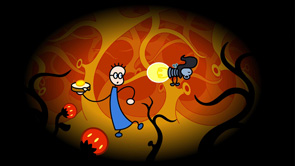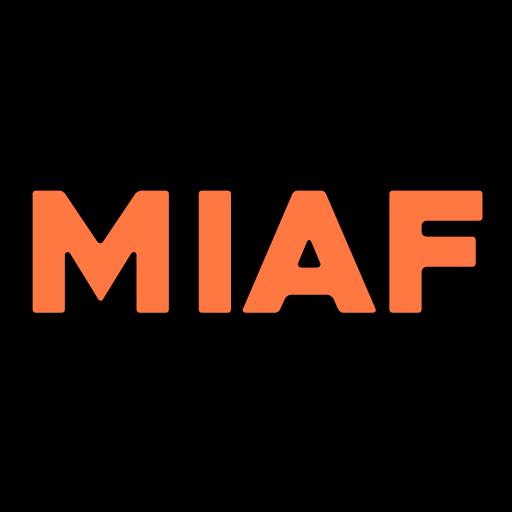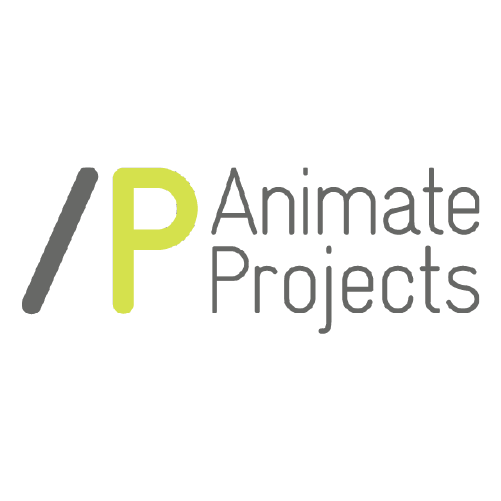The Ottawa International Animation Festival (OIAF) is one of the most important events we visit as we plan each successive LIAF. The OIAF Artistic Director, Chris Robinson is renowned for not being afraid to call it the way he sees it, is the author of an expanding catalogue of books on a variety of subjects and writes a regular column for the Animation World Network website under nom-de-guerre ‘Animation Pimp’. During OIAF, a deconsecrated church is turned into a hallowed venue (intimate and intimidating in equal measure) that hosts screenings, talks and a series of recorded one-on-ones that will turn up on-line eventually as “Pimp-Casts”.

I’ve been following Andreas Hykade around Quebec for days in the hope of getting some face-time to do an interview for this article. A planned hook-up at the National Film Board of Canada office in Montreal earlier in the month gets iced when some critical meeting times there get changed. Trailing him and his NFB producer, Marc Bertrand, to a McLaren exhibition in Quebec City falls through when part of the building burns down. Dramatic! We pass like ships in the night on Dalhousie St in Ottawa a few days later but we’re going in opposite directions and Old Man Time seems to have his insistent hand on both our backs. And then it occurs to me – why not let Robinson do all the heavy lifting? I will sit in on the recording of his Pimp-Cast with Hykade. Hykade’s latest film, Nuggets had already screened in the festival and his appearance at the “Meet The Filmmakers” session the following morning was set to be one of the highlights. It was a film that a lot of the animation savvy OIAF audience had been keenly anticipating and it was clear from the outset that they had not been disappointed with what they had seen the night before.
 As I sit and listen to the questions coming his way from all quarters, I reflect on the span of Hykade’s films. One of his earliest films, Ring Of Fire (2000) is about as different from his recent works as it is possible to get. And these differ significantly from his beautiful, painterly films such as Lived In The Grass (1996) and The Runt (2007). What kind of mind can generate a body of work that embraces intricately lined, more or less pornographic infused works such as Ring Of Fire with crisp, ultra clean-styled, block-coloured works for kids such as Tom And The Slice Of Bread With Strawberry Jam And Honey and am equally clean but more narratively ambiguous works such as Nuggets which might be the story of a little kiwi bird snorting up a lot of drugs. He gave as good as he got at the Meet The Filmmakers session but it all came together in a vastly entertaining whole when he sat down with the Pimp as the Ottawa rain hammered on the roof of the church. Robinson and Hykade have been friends for more than a decade, Hykade has contributed the artwork for OIAF posters over the years and the festival has shown pretty much all of his films. Anyone who made it through the rain was in for a special night.
As I sit and listen to the questions coming his way from all quarters, I reflect on the span of Hykade’s films. One of his earliest films, Ring Of Fire (2000) is about as different from his recent works as it is possible to get. And these differ significantly from his beautiful, painterly films such as Lived In The Grass (1996) and The Runt (2007). What kind of mind can generate a body of work that embraces intricately lined, more or less pornographic infused works such as Ring Of Fire with crisp, ultra clean-styled, block-coloured works for kids such as Tom And The Slice Of Bread With Strawberry Jam And Honey and am equally clean but more narratively ambiguous works such as Nuggets which might be the story of a little kiwi bird snorting up a lot of drugs. He gave as good as he got at the Meet The Filmmakers session but it all came together in a vastly entertaining whole when he sat down with the Pimp as the Ottawa rain hammered on the roof of the church. Robinson and Hykade have been friends for more than a decade, Hykade has contributed the artwork for OIAF posters over the years and the festival has shown pretty much all of his films. Anyone who made it through the rain was in for a special night.
Before things could get underway in earnest, there was the “church thing” to deal with. Hykade has an interesting and checkered relationship with “the church”. Born and raised in central Bavaria, he spent much of his childhood as a choirboy. He remembers vividly the day that Pope John-Paul II visited and actually spoke to him and touched his head.
For all of that, it has been 33 years, he says, since he has been in a church. But he has detailed and apparently fond memories of the churches he knew as a child. With only modest encouragement, he talks eloquently about the kind of artworks the churches of his childhood provoked. In particular, he talks of how the people in the village he lived in would create paintings and drawings of things from their everyday experiences but would always include a picture or a likeness of the Holy Mary in one corner or another of their artwork before pinning it to the wall of the church. The building, by Hykade’s account, was liberally covered with layer upon layer of these drawings and his unspoken point seems to be that it was this forest of everyday art that gave the church the soul that Hykade recognised and respected more deeply than the business name chiselled on to the rock wall of the building.
Early in life, Hykade realised he could draw. This often expressed itself by way of drawing realistic portraits of people from photographs. This kind of art didn’t scare the horses, it didn’t frighten parents into concerns that their son might pursue life as an artist and it impressed people around him. But behind the crowd pleasing caricaturist, there was a young man who was privately listening to the Velvet Underground, seeking out the films of Phil Mulloy and reading Robert Crumb comics.
He attended several art and film schools and although he did not finish any of them, he found himself with the need to scratch that itch to make a static picture move – he wanted to be animator. His very first animated film did not necessarily shine a bright light on the road marked ‘Success’. Titled Jochem In Search Of His Face, it was shot on a 16mm camera and came in at a little under six minutes.
“It was about a boy searching for his face”, Hykade explains, slowly and a little reluctantly, probably aware of how this is going to sound when he finishes the explanation. “It included the Pope, a famous politician of the time and a faceless whore who continually jacks off the boy until he eventually ejaculates onto the camera. You probably haven’t seen it”, he adds after a perfectly timed pause. He was 15 years old.
It was a start though. Hykade had been bitten by the animation bug and he headed for London. Getting certain types of work in the animation industry in London was not that hard but his ambition to direct was thwarted at each turn. “They look at a German wanting to be in charge and they immediately see a small, black moustache”, he says with some relish.
Ever the pragmatist, he headed back to Germany to undertake some serious animation training and he wound up folding many of the experiences he had had in London into his ‘first’ film, We Lived In Grass. It is an extremely complex film, laden with concepts and complexities. It also contains audaciously ambitious artwork. “I definitely threw too many things in the soup”, says a reflective Hykade. “I could have done ten other films out of that. But on the other hand, it has so much energy. Part of me wants to go back to that and find the raw idea”.

Then came Ring Of Fire in 2000. Utterly unique, confrontingly entertaining and presenting an all-enveloping world oozing with a kind of deviantly hilarious, velvet grotesquerie. BIG in every sense of the word. Seeing this in either 1:1.85 or cinemscope ratio on the big screen for the first time was a dramatic experience to withstand. It remains a locked in member of the “desert island film” list and was a couple of million pixels of confirmation that animation is the most unique and imaginative of all the artforms.
Hykade harboured a dream that Johnny Cash might be enticed to do the narration for the film. It makes sense, it’s a “good fit”, as the saying goes. Or maybe not? Cash loved the script but when he was sent the film he erupted in fury and tried to block the use of the name Ring Of Fire. Simply, Johnny Cash hated the film. One can only imagine the look on his face as he encounters “real” animation for probably the first time in his life. As luck would have it, Hykade was working his way through the King James alternative version of the Bible at the time and in there he encountered the phrase Ring Of Fire.
“Ah Ha, that’s where I got the name from”, Hykade proclaimed, practicing for the day he might have to confront Johnny Cash. “Not from your crappy pop song”.

Hykade is probably best known in Europe for his long running TV series Tom And The Slice Of Bread With Strawberry Jam And Honey. In some places it has been running continuously for ten years. It came about by accident. At Christmas times, Hykade would draw simple caricatures of his producer (Tom) and in these caricatures, Tom would be sent to war or situated with prostitutes or suffer some other humorously degrading fate. But as Hykade grew into fatherhood, his outlook on many things changed and these pictures morphed into gentler scenarios that could amuse kids as well as adults.
When that, in turn, morphed into a project that looked worthy of attracting funding and becoming a viable project, the original idea had been to make a feature length film. But the money train dictated it become a series of TV episodes and for a decade it has underpinned Hykade’s professional career. Production of the last “Tom” episode finished some time ago and that coincided with Hykade wondering if maybe, just maybe there was not something more to life than bread and strawberry jam and honey.
Hykade considers himself to be blessed with the good fortune to work at Studio Bilder. He regards it as the best studio in Europe and credits the owner of the studio with understanding and supporting the needs of artists because he is an artist himself.
Together they planned Hykade’s next project which was to be an epic film that intertwined twelve separate stories. But at a critical juncture of the project, Hykade underwent a significant health scare. Forced to stop work and undergo explorative surgery to detect whether or not he had cancer, he was forced to spend ten anxious days in a hospital bed recuperating from the surgery and waiting for the results. “Bring me my light box and 2,000 pieces of punch paper”, went out the command.

Over the next ten days, Hykade produced every drawing he would need to create what became Nuggets, his latest film. Working from 5.30am until midnight, on a good day he could produce 300 drawings. At the end of the ten days, he had all the artwork he needed and a clean bill of health. A small team of just six people set about completing the film and – voila – a brand new Andreas Hykade film is set to take the screen by storm. “I wanted to make a film that acted a bit like a thermometer”, he says by way of explanation. “At the beginning life is sweet and there are no problems. But by the end….. not so much”.
Interestingly, Hykade volunteers that timing is not his strong point. This comes as a bit of a shock to most of the people present who know his work. His timing in films like Love And Theft seems nothing short of impeccable. In Nuggets it almost seems supernaturally perfect.
“My natural timing is not good so I always work that out well in advance and make sure it is working properly”, he says. “I always have an old fashioned dope sheet so I can hit the beat exactly. I don’t want to produce a single image that I won’t get to use. I always want to avoid that”.
So what’s next, Mr Hykade? Good question and there is a very specific answer as it turns out. And a surprising one. In the coming months, Hykade will work on a co-production with the National Film Board of Canada to create a film that explores the enduring power of the Mother Mary figure in the Christian church. Drawing deeply from his childhood experiences with religion as an entity and more specifically from his memories of connecting art with the church, the film promises to be provocative, even if the concept of it is not fully formed in Hykade’s mind just yet. Pushed to nominate an audience for this film he suggests that it will be “for people who are in the process of intersecularity”. That is a pretty interesting audience to contemplate whilst sitting in a deconsecrated church listening to somebody who gives little indication of giving organised religion too many free passes.
These days audiences are important to Hykade. “Nuggets” is about addiction and he had a teenage audience in mind when he was making it because he feels the message is a good one for them. And he is happy to take on his critics.
“I always understand my critics, they are my most important source”, he ventures. “With Tom we got lots of criticism about how dumb it was and we used that to change the characters. I try to use my critics more than my friends. Your enemies will always keep you alert and alive”.
All in all, not a bad message to take out into the rain.
Malcolm Turner, LIAF Co-Director
Andreas Hykade will be joining LIAF Director Nag Vladermersky for a Q & A after the screening of his films on 30 October.
At Barbican book tickets
We’ll also be screening Tom & the Slice of Bread with Strawberry Jam and Honey, complete with an introduction by Andreas. As well as this, Andreas will also be running an Animation Masterclass Both are on 1 November.
Thank you to the Goethe Institute for making the visit of Andreas Hykade to LIAF possible.
















